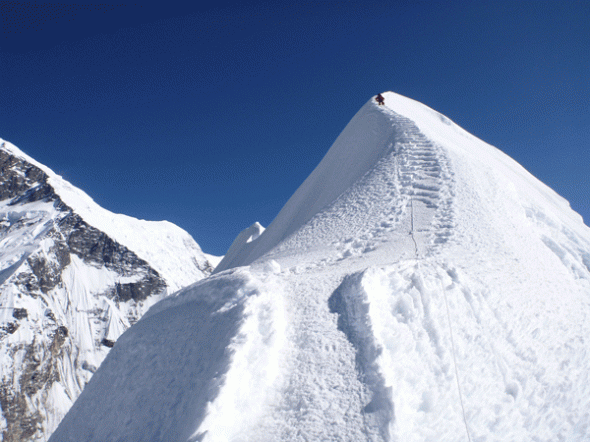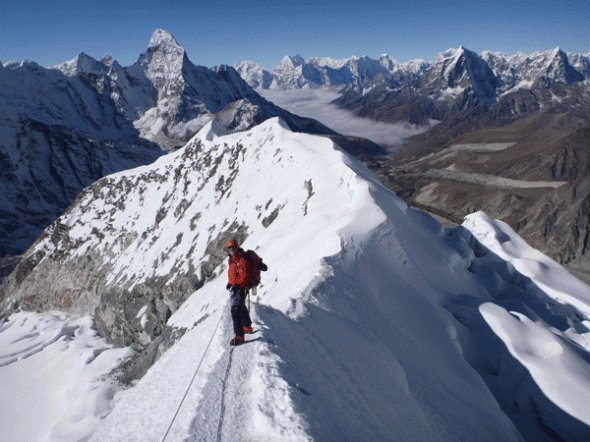Offering trekkers the chance to climb a 6000m peak with just some basic mountaineering skills, Island Peak is an ideal first Himalayan summit says Jon Gupta
Island Peak – or Imja Tse as it is know locally – is a tantalising prospect. At 6,189m it tips over the magical 20,000ft threshold and is a justifiably popular mountain.
Soaring high into the sky, Island Peak is a technically straightforward climb, has a superb snowy summit ridge, outstanding 360 degree views across the Himalaya and is easily accessible – no surprise then that it attracts over a thousand trekkers every year.
I have just returned from nearly six weeks in the Khumbu, of which some was spend guiding teams on Island Peak for Tim Mosedale Logistics. So what makes Island Peak so great? What equipment do you need to make an ascent? Just how technical is it? Are you ready to take on your first Himalayan giant?
Head for heights
With around seven lodges to choose from, Chukhung village is your gateway to an ascent on Island Peak. Chukhung is situated five days trekking from Lukla on the north side of Ama Dablam and at the snout of four glaciers which descend the slopes of Nuptse (7861m), Lhotse (8516m) and Ama Dablam (6812m). In Chukhung you are right in the heart of the Khumbu, underneath the enormous south face of the worlds fourth highest mountain, Lhotse, and the imposing north side of Ama Dablam, whose incredible west ridge sweeps right across the skyline towards Island Peak. You are also rewarded with superb views of Taboche, Cholatse and Arakam Tse – all over 6000m. Chukhung is usually where you meet your additional local crew, and any last minute gear requirements can be sorted too.
Prior to an attempt on Island Peak, most parties will spend an additional day acclimatising in the previous village of Dingboche (4400m), where you can trek leisurely up the slopes of Nangkar Tshang to around 5200m. Most often this will involve an afternoon spent at the Dingboche bakery, drinking tea and sampling pastry delights! Chukhung (4730m) is two to three hours further up the valley and usually the next day a similar pattern is observed taking advantage of the peak just north of the village, Chukhung Ri (5550m).Chukhung Ri is brilliant acclimatisation for Island Peak and should be a must on everyone’s itineraries. Not only do you reach 5550m but after just a few hours you are rewarded with sensational views of all the peaks surrounding Chukhung. You can now see over the Nuptse Glacier and across towards Pulmori (7165m) and Cho Oyu (8201m,) and over behind Island Peak to Baruntse and the worlds fifth highest mountain, Makalu (8462m). Whatever you do, make sure you bring a good camera!
After a couple of nights at Chukhung you pack your kit and prepare for your trek to Island Peak Base Camp, a pleasant two to three hour trek to 5087m on the south side of Island Peak. Heading south out of Chukhung village you pass over the tumbling Imja Khola river fed by the nearby glaciers – here, freezing cold ice formations build up on all exposed surfaces. From here you are on lateral moraine jammed between the Lhotse and Ama Dablam glaciers and, gaining a small ridge turning westerly, you follow the narrow worn path as it ducks and dives over loose, dusty terrain. The path turns again and heads directly towards Island Peak in the distance. After an hour and a half you pass into a large open valley with Island Peak prominent above you at one end and Cholatse at the other end behind you, all the while Ama Dablam stands way above looking down on your progress as you move deeper and deeper into the Khumbu mountains.
Just before Base Camp you drop down to the foot of the mountain before easily traversing around to your new ‘home’. It was here that I gained a real sense of why they call it Island Peak. I knew from looking at the maps that it is a ‘stand alone’ mountain, similar to Kilimanjaro for example, and almost all the way around its base it is surrounded by glaciers, protecting itself with a maze of deep crevasses – like a moat around a castle.

Less trodden path
Island Peak summit was first climbed in 1956 by a Swiss team as a training exercise in preparation for Mount Everest and Lhotse. Nowadays around 300 teams try climbing it each year. This may sounds like a lot but, compared to the super-busy peaks like Mont Blanc and Kilimanjaro, Island Peak is relativity quiet and enjoyed often by only a dozen a day during the climbing seasons.
Base Camp is tented accommodation only and this is likely to be the first time you camp on the trek. Most agencies have a cook and dining tent where the magic happens and your talented local sherpas will rustle up nutritional energy-filled lunches and dinners for you before the big night. We enjoyed my Nepalese favorite of egg drop tomato soup and a plate of fried potatoes, with some type of coleslaw and hot dog sausages!
After a rest for a few hours to adjust to the altitude and to allow the team to move into their new homes, the climbing Sherpa, Hemanta, and I run a technical ropework session where, for the first time, many of the climbers practise using ascenders and descenders. On Island Peak there is a short section where fixed lines are put in for safety and it is imperative that each individual knows how to not only ascend and descend these lines but also how to do it in a systematic, safe and easy method – while wearing big gloves!
A few hours is spent learning the techniques required – jumars, fig 8s, screwgates, cows’ tails – and safety lines take on meaning, their uses are learned and everyone is happy with the prospect of fixed lines high up on Island Peak’s glaciated cap. In the early evening we take a leisurely walk along the base of the mountain and show the group where the route goes in the morning. We will be setting out for the summit at 01:00 in just over eight hours time, so we head back to camp for an early ‘carb heavy’ dinner and then to bed. There is an excited buzz in the air over dinner as I explain a few last minute details about what to wear and the importance of keeping warm, hydrated and using rest stops effectively, as well as rough timings and expectations for the summit day. I strongly believe that you should not have to turn back on a summit day for something that is within your control – being cold and dehydrated, for example, which leaves only weather, altitude sickness and injury as good reasons for stopping and returning to camp. A few of the team have last minute questions and, once these have been answered and Nalgenes have been filled with boiling water (to act as hot water bottles), I urge the team to head to their tents for five hours sleep.
Outside the sky is clear and calm with just a gentle cool breeze against my face. Looking upwards I am mesmerised by the sheer number of stars in the sky. Of all the places in the world to which I have been fortunate enough to have travelled, I have never seen a sky like this. Millions and millions of stars flood the sky, twinkling silently at me, more appearing every second as my eyes slowly adjust to the darkness. The Milky Way is more obvious than ever before, and cutting across the sky behind the skyline of Island Peak, I can see the glow of the night’s promised full moon rising slowly.
READ THE REST OF THIS ARTICLE
To download a PDF of the complete article, with trek info and region map, CLICK HERE

